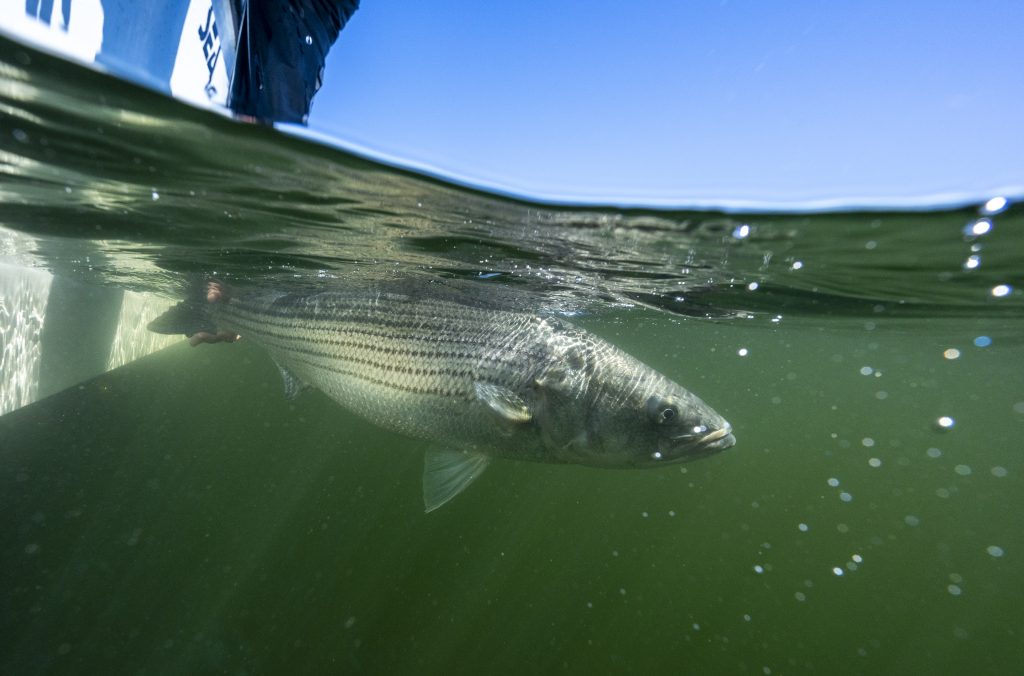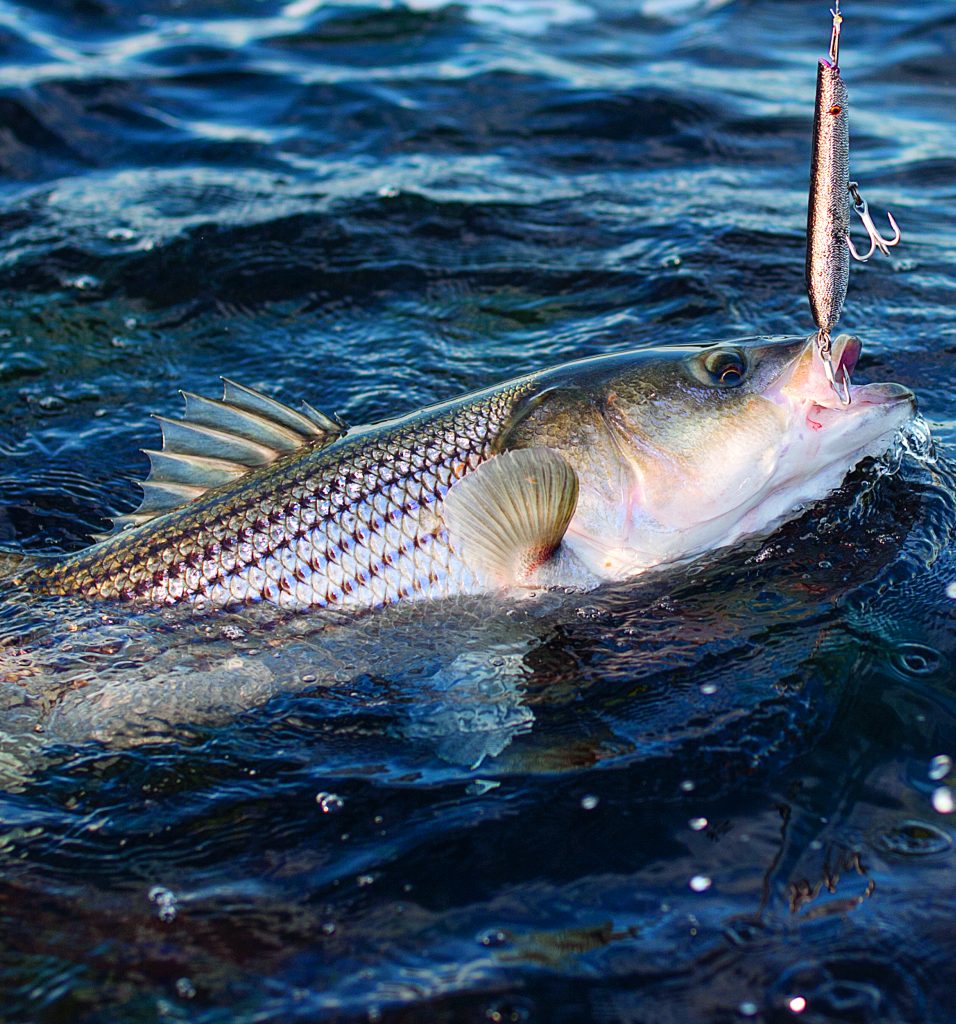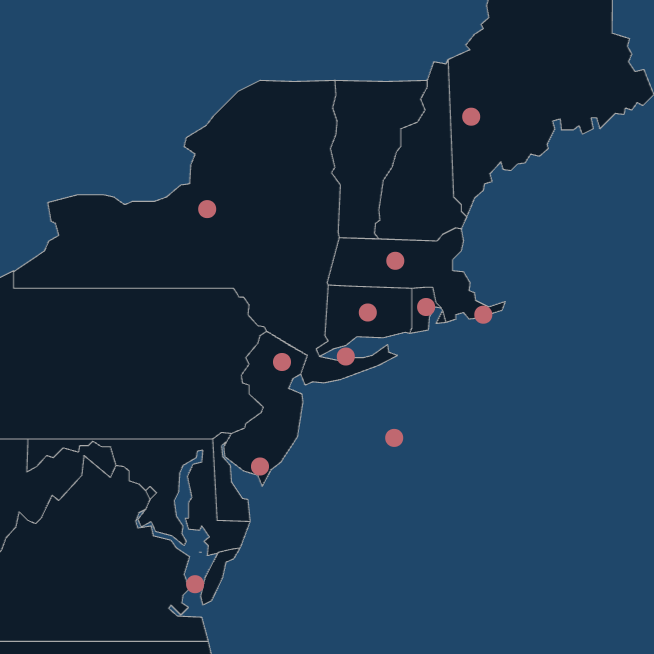
It will come as absolutely no surprise to those reading this that the striped bass reigns supreme as the top recreational target along the Atlantic coast. Even as this overfished species is in the midst of a rebuilding period, resulting in increasingly restrictive regulations that now include a coastwide 28- to 31-inch slot limit and one fish bag limit, directed trips by anglers have averaged well above 10 million annually in recent years.
More surprising to some, however, may be the outsized impact that recreational fishing has on the striped bass resource. Overall, it is estimated that the recreational community is responsible for 90% of removals, both due to harvest and due to mortality of fish that die after catch-and-release fishing. The latter is no trifling matter given that 90% of recreationally caught striped bass are released. According to the Atlantic States Marine Fisheries Commission, in 2022, post-release mortality accounted for an estimated 40% of all recreational removals, or about 2.7 million fish. Complicating factors further is the fact that the assumed percentage of fish that die after release—9%—is based on a 30-year-old study that doesn’t account for the wide range of techniques, fighting/handling practices, fish sizes, and environmental conditions experienced by today’s anglers.
Scaling Up Previous Research
Fortunately, with the help of the Massachusetts Division of Marine Fisheries (MA DMF), everyday anglers now have the opportunity to help scientists determine what influences a striped bass’s fate after release and eventually provide an updated baseline estimate of post-release mortality.
“There are two major contributors to the overfished status of striped bass,” explains Ben Gahagan, the Recreational Fisheries Program Leader at MA DMF. “One is a lack of successful spawns and the resulting low numbers of baby striped bass being produced, which is driven by environmental conditions and is out of our control. The other component, however, is fishing effort—where, when, and how anglers are catching striped bass—and with so much of the striped bass issue coming down to post-release mortality, size and bag limits can only get us so far.”
To better understand these components of fishing effort and how to they relate to the fate of released striped bass, for the past year, MA DMF has enlisting anglers to participate in its Striped Bass Citizen Science Project. It’s the next step in a multi-year process that began with an acoustic tagging study comparing post-release survival of fish caught on bait with J-hooks versus circle hooks (non-offset circle hooks have been required for anglers targeting striped bass with natural bait since 2020). “Through our hook study, we were able to link survival with the condition of fish when they were released,” says Dr. Micah Dean, a Senior Marine Fisheries Biologist at MA DMF and partner in the citizen science initiative. “Now, through citizen science, we can learn how different factors—for example, hook configurations on lures, fight time, air/water temperature, and others—impact condition, and by extension, mortality.” A secondary benefit of this effort is to inform best practices that anglers can employ to maximize survival after release. The success of this critical work, funded through Massachusetts saltwater recreational fishing license funds and the Massachusetts Environmental Trust’s Striper Conservation Fund—which receives money from the Striped Bass Conservation license plate and individual donations—hinges on the widespread involvement of striped bass anglers.

Getting the Public Involved
While Massachusetts may be a hub of striped bass activity—three times more stripers are released there annually than in any other state—the team is not looking for anglers only from the Bay State to participate. Anglers from Maine to North Carolina are invited to join the effort and give the research team the broadest possible representation.
To recruit participants during the project’s first year in 2023, Gahagan and Dean took an “all of the above” approach, partnering with groups like On The Water, Salty Cape, Mouths of the Merrimack, and the American Saltwater Guides Association to help spread the word. “Striped bass anglers are a dedicated community, and we really valued the opportunity to tap into that,” Gahagan said. “Whenever we worked with industry partners to amplify our message, we saw a significant bump in participation.”
Participating anglers are sent sampling kits that include a stopwatch, tape measure, and thermometer, and can submit their catch data either on paper or via the smartphone app GotOne. Anglers who submit at least one report receive a pair of pliers, and a weekly raffle for active participants awards a lucky winner a rod-and-reel combo.
Results to Date
In 2023, 162 active anglers recorded a total of over 3,500 fish throughout the course of about 900 trips. Thanks to support from Backcountry Hunters and Anglers, this data can be viewed through an online portal. While MA DMF staff are still wading through results and look forward to building on this initial dataset in 2024, some initial findings stood out. “We found that larger lures tended to catch larger fish,” Dean shared, noting with a chuckle that this was the case even after removing tube-and-worm rigs from the analysis. They also found that fish fought for longer periods of time and kept out of the water for more than two minutes tended to do much more poorly. And, larger fish were usually fought longer. While these results were fairly intuitive, being able to understand the relative impacts of these variables is key to pinning down an overall post-release mortality estimate.
Other early results were more eye-opening. “At first, we didn’t think we were seeing any effect on fish condition with increasing water temperature, but that changed once water temperatures bumped above 75 degrees,” Gahagan explained. However, since the lion’s share of participants in the project’s first year (about 85%) were in Massachusetts, there wasn’t a lot of warm-water information to see how strong that connection was.

Another interesting, if preliminary, find was the effect of lures with multiple hooks. “We didn’t see a big difference on fish condition between plugs with single hooks and treble hooks, but plugs with multiple hooks tended to inflict more damage, regardless of whether they were singles or trebles,” Dean said. After all, even a single hook can be an issue if it lodges somewhere sensitive like in the gills.

What Data Do I Record?
For each fish caught, participating anglers are asked to record:
- State
- Angler experience and number of trips per year
- Trip date
- Air and water temperature
- Tackle type (e.g., surface lure, fly, bait, etc.)
- Bait or lure specifics (bait species, lure size, hook type, etc.)
- Fish size
- Fight time
- Handling time
- Hook location
- Injury level
- Vitality level
A Call to Action for 2024
2024 is the second and final year of this citizen science effort, and MA DMF wants you to get involved.
In particular, the research team is looking for anglers all along the coast, including those in warmer-water locales in order to gain more information on the potential linkage between water temperature and release condition. They’re also seeking information on the impact of various circle-hook sizes and gap widths, which is notoriously difficult to assess given the different sizing across manufacturers.
To sign up, visit MA DMF’s Striped Bass Citizen Science page and fill out the online form or download and sign up through the GotOne fishing app.
This critical work, coupled with survey efforts to assess broader angler practices, can supply scientists and managers with a new reference post-release mortality value for future consideration. “Striped bass are a special fish for anglers—fun to catch and easy to access,” says Gahagan. “As a community, it’s critical for us to come together and supply the science needed to help steward the resource back to where it should be.”
To join the Striped Bass Citizen Science Project, visit this link.
Questions? Email MA DMF at striper@mass.gov.
Related Content
Help Striped Bass Survive Catch and Release


I believe sharks are a major problem pertaining to other fish species off of the new jersey coast.i also believe alot of different fish species go through cycles, just like rabbits do.nature has a balance.
Seals are the issue. When seals weren’t around, the striped bass population was healthy. But as the seal population started to boom, it had an adverse effect on the striped bass population. Should we reinstate the seal bounty that ended in 1962?
Gill nets in the Cheaspeake Bay mortarly injured many stripers 365 days each yr
I totally agree ? and sharks ?are an issue the usually take big stripers because small ones can get away easier..well said ?
I hate releasing fish that are as good as dead because they are not between 28”-31”. I would be fine with one fish/ day period. Not surprised at all by the mortality of bass in warmer water. After all we have to release the big fish and they are the ones more susceptible to stress from warm water.
You can’t get more humane than using circle hooks and making certain that you do a quick release. I have nearly 100% lip shots with circle hooks and it sets up nice for fast release times. If the fish seems a tad sluggish I hold it by the lip and move it a bit under water to get a little water through the gills and they swim away with vigor. I also believe what Vince has said. I’ve never seen as many seals near my fishing spots from shore as I’m seeing now and the amount of hookups I’m getting now are way down from 5 or 7 years ago.
I`m not too thrilled with slots. I`m on a low and fixed income (SSI) and fish for food. If I have to catch 10 or 11 fish to harvest 1 then theoretically I`m killing 2 striped bass, if after catching the 1 at 28″ or above, I just stop fishing for bass and try for mackerel, flounder, or other species and no longer affect the mortality of the bass. If you`re not fishing for food then you are eventually killing 10% of your catch and release for fun. If you catch a 40″ plus fish that feeds you for a month or more, or you were to catch and release 100 fish in a month (killing 9 fish) what would cause the greater damage to the population. Peace and brother love to you and all.
It is shocking to learn that catch and release is responsible for such massive striped bass mortality. It is time to re-evaluate the practice and get fishermen who should be leading in conservation of this beloved sport fish to treat them with more respect.
Maybe MA DMF should be recording incidents where responsible anglers witness the cruelty of other anglers who drag their bass on the beach, rocks, or plop them down on a hot deck. I have seen this over and over again. Holding a large fish on your lap for a picture can be a death sentence for the fish. Maybe OTW should stop publishing pictures of this sort.
How would you like to have one eye pointed directly at the sun for a few minutes without being able to shut your eyes? I suspect that many fish are blinded in one eye as a result of being taken out of the water and laid out flat while someone takes a picture or a measurement. We should all be thinking about this after so many dummies stared at the eclipse and have permanent eye damage despite all the warnings in the media.
Circle hooks (in line) work on plugs, lures, and flies including tube and worm rigs. I have tried them all with no abnormal loss of hooked fish and perhaps fewer than normal losses. Crushing the barbs on circle hooks does not seem to result in abnormal losses of hooked fish and it makes removing the hook far easier.
The seals chase out the bait and the striped bass can smell the seals so they leave too. Then you catch – – NOTHING!
The cormorants can swallow a 2lb. trout whole. Then the rest (what’s left of them) hide in the weeds for the rest of the day.
Then you catch – – NOTHING.
The MA Dept. of Fisheries does NOTHING to control these huge predatory populations.
They are pretty good at taking your license money and doing NOTHING with it except disappearing it.
Years ago my wife and I each caught a striped bass from an elevated bridge pier in NC. Both were about 2 inches too short to keep. I just dropped the first one down and it hit the water on its side and floated away barely moving. The next one I immediately ran down to the end of the pier ( 500 feet or so), got into shallow water with the fish and tried for about 10 minutes to revive it enough to swim away on its own. It slipped away from my grip and drifted off along some rocks. I wasn’t fishing for striped bass in particular, but I realized then that it is best to have a net you can drop down to the water and give the fish a much better chance.
As a recreational angler who has practised catch & release for about 99.9% of the striped bass I’ve landed, I am having a hard time believing the mortality rate for released fish is that high. I feel this number is being inflated by special interest groups to be able to point the finger at recreational fishermen. If post release mortality was this high, one would think you would see floating dead stripers all through our waters. That being said, I think the study being cited here research into the effects of various hooks & water temperature is much needed. Anecdotally, I would say that trout are much less hardy than striped bass yet catch and release protected trout seem to thrive in those waters. I will try and keep an open mind and look forward to the results of the ongoing studies about this topic.
Sorry. Not sorry that you are having a hard time believing it. It should be illegal to hold a fish up for a picture if it is to be released. Common sense.